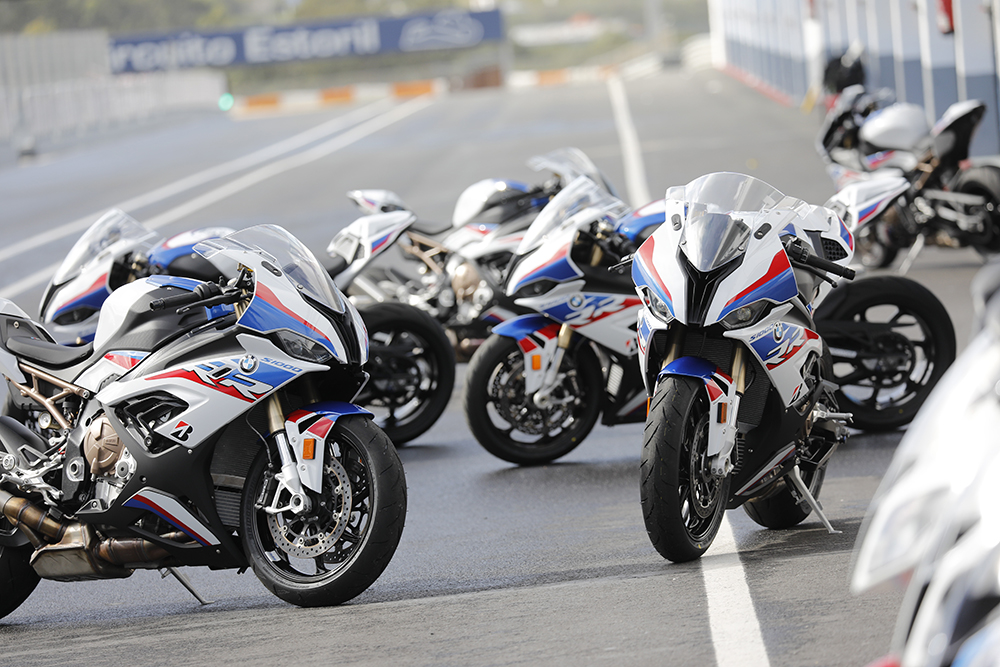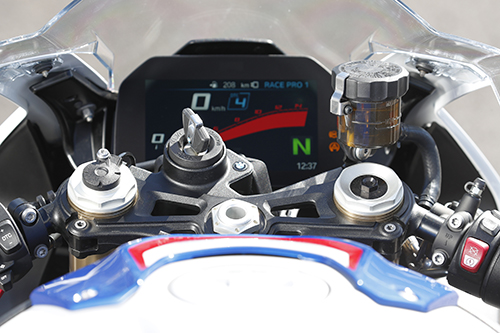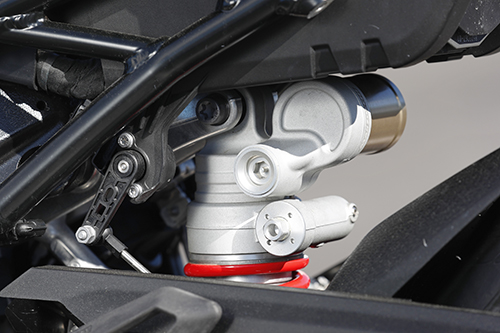A sunny warm day at the Jerez circuit in Spain and a brand-new BMW S 1000 RR M Sport. The perfect recipe to put the supposedly improved model from the German manufacturer through its paces. Since the inception of the RR in 2009, we’ve seen some substantial improvements in all aspects of the package. Those of you following the evolution of the BMW from the start will know that horsepower has never been an issue, and that over the last 10 years the Bavarian powerhouse has tamed that power well with revisions and electronic improvements. The chassis has become more forgiving and the engine calmed. The 2019 version holds yet another element in the evolutionary chain.
At first glance the new S 1000 RR is striking, sexy and sleek. While it’s easily recognisable as a BMW, badges aside, the styling has stepped up a level and looks like a two-wheeled version of the highly coveted M class four-wheeler.
Bragging rights these days, aren’t what they used to be. It’s more impressive to ride a 200+ horsepower superbike that puts the power to the ground, rather than to ride a weapon of potential mass destruction. Superbike engines have been capable of big power for years and the S 1000 RR has gone from being a fire-breathing monster a decade ago, to something worthy of accolade in the motion department.
The power is impressive and the 2019 version has noticeably more torque, mid-range and top end than its predecessor. A lot of this will be down to the variable valve technology it features, which seems to be the flavour of the minute, and has also been introduced in other BMW engines this year. The transition between the two cam timing profiles is faultless, the power delivery is silky and there is no throttle connection lag between physically opening the throttle and what’s being delivered.

It picks up engine speed noticeably faster than the older bike, so not only is the extra zip in throttle response decidedly user-friendly rather than intimidating, it’s also a factor in the way the new bike is so easy-steering, with a reduced gyroscopic effect on the handling – and that’s further magnified by the carbon wheels fitted to the M-bike. While the engine has gained substantially in many areas, it’s still quite peaky and makes the bulk amount of its power high up in the rev range. It’s a strange sensation as it comes into the meaty part of the power curve; the RR feels like it is making more power than the engine revs indicate it should be. No doubt, the shift cam will be responsible for this more usable rev range. It is a thrilling ride and, although it’s fairly aggressive at times, the electronics assist the delivery substantially. When you have over 200hp up your sleeve you don’t need all of the revs before every gear change; a simple short shift keeps things in check… although everyone loves a fourth-gear power wheelie.
BMW electronics are world class and continue to shine with each new model. The RR’s dashboard adds to the experience, with the super high-contrast TFT display placing all of the system’s vitals right in front of you in a clear and concise layout. The attention to detail sets it apart; as the rpm climbs each number on the digital tacho is emphasised, making it clearly visible in your peripheral vision, along with distinctive colours signalling gear, speed and shift light. While this is all aesthetically pleasing, it’s the algorithms and programming in the brain that’s the icing on top. BMW’s standard electronics have always been impressive and now the S 1000 RR gets a further upgrade with a six-axis Inertial Measurement Unit.
These sensors have been in the racing world for a while now and, like every advancement in technology, it eventually filters down. In a nutshell, the IMU measures directional G force. Unlike electronics systems of old, where the ECU would step in and reduce power once a certain percentage or wheel slip was reached, the sensor can take other factors into account when the brain is making decisions. Lean angle, acceleration and brake force are accounted for and compensation applied by the ECU. The refinement is much greater and far more sophisticated than previous years.

On the track the system performs exceptionally in all modes, with decreasing levels of intervention from Rain mode, through to Race. In days of old the traction control system was fairly crude; traction control interference was often harsh and upset the bike’s suspension movements. Over the years refinements have been made to the ones and zeros in the computing department and this has resulted in a far smoother operation.
Now with the addition of the latest smarts, these constantly recalculated cuts to the power curve offer the rider a silky power delivery with far more feel of what’s actually happening underneath you. The ECU delivers power consistently and without unnecessary reduction of torque both on tight and hard acceleration corner exists as well as long and open sweepers.
Traction control systems are often set apart when the bike is at maximum lean angle, where safety measures are needed most. As the bike leans, the tyres’ rolling radii change, creating a difference in front vs rear wheel speeds which can result in premature intervention on more primitive systems. With an IMU, the difference between front and rear wheel speed isn’t the only deciding factor.
The new S 1000 RR is really going above and beyond, making it easier to manage the raw power available. The new RR has a well-refined wheelie control system and also race track ready features such as the pitlane speed limiter. While heated grips also make an appearance on the new model, some enthusiasts question why a road legal racebike needs this. I can tell you from experience they are certainly a welcome addition at 3am during a 24-hour endurance race, so why not?! I’m sure those of you riding the annual pilgrimage to Phillip Island each year won’t mind this, either.


What is even more impressive than all this tech, is how it behaves when the features are turned off and the only thing between 207hp and the ground is how far the throttle is twisted. The engine and chassis still maintains a fantastic relationship that highlights just how much effort BMW has gone to in order to create a rider friendly and high horsepower combination. The engine qualities, along with the advancement in electronics, do a great job at saving us from ourselves.
The ABS function is the most impressive of the electronic aides, especially in the rain. Adjustments are made to the braking force faster than your fingers can react on the brake lever in the event of a slippery surface. As you may know, the system works in a similar way to traction control but in reverse, removing brake force if the front wheel is decelerating too quickly. Motorcycle ABS systems react the most with aggressive brake force and often pull braking effort away from the brake caliper before any real danger of locking the front wheel is apparent. The new S 1000 RR braking system is the best yet, with excellent lever feel and plenty of stopping power. It’s ABS system also copes with substantial braking force while maintaining direct lever connection to the front wheel.
On track, the ABS control didn’t feel as though the ECU was taking over and pumping the lever out, which is a pretty disconcerting feeling when the edge of the corner is coming up quickly! Trail braking was a breeze and I felt no brake fade whatsoever – it’s surprising BMW has allowed so much braking potential in the ABS range. At one stage I wasn’t even sure the system was working until I hit a wet patch on track and it intervened perfectly. Exactly how it should feel.
The S 1000 RR is typically one of the most sensitive chassis’ around which can make the working window pretty small at times. The Beemer comes with a fairly neutral setup; that is a well thought out balance of steering agility and stability. It’s a little on the soft side for the racetrack, but you can’t please everyone (especially me).


The DDC suspension, or Dynamic Damping Control, is always at play and mostly it is doing the right thing; offering maximum damping wherever possible. Although in some instances it can induce instability during excessive wheelspin by closing or opening the damping in low adhesion circumstances.
The BMW has managed to keep its quintessential feeling, which is a positive, especially during aggressive track riding. The RR has always been able to give a large amount of feedback to the rider in standard guise, most noticeably and importantly from the front end. It doesn’t feel too front heavy either, even with the added weight distribution to the front tyre of this year’s model. The fork copes well with heavy and aggressive braking from high speed, yet doesn’t seem to suffer from being over damped on low-speed hairpins and change of direction.
One of the big improvements to the chassis comes from the revised ratio of the rear suspension link which allows for a softer rear-spring rate. This gives an all over greater feeling of compliance on bumps from the suspension but at the same time maintaining geometry. The package works well on the racetrack which makes the RR a well-rounded, confidence inspiring machine. It’s the best handling S 1000 RR yet and, despite some small fine tuning to suit the individual rider, it’s hard to fault.
First impressions are often the most accurate and there is no denying the new offering is appealing on many levels. The new RR does everything it should and then some. It’s arguably the benchmark of the elite category and it has proven that this bike was built with a purpose in mind. It’s definitely easier to define the S 1000 RR as a street ridable track weapon than the other way around.













